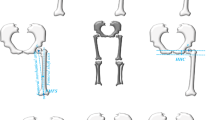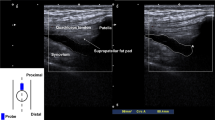Abstract
Objective:
Osteoarthritis (OA) most commonly affects the patellofemoral compartment of the knee, and is a major cause of pain and disability. Structural changes that evolve prior to the onset of symptoms can be visualised using magnetic resonance imaging (MRI). There is little known information about the role of adiposity on the early structural changes in the patella cartilage in younger, asymptomatic adult females.
Methods:
One hundred and sixty asymptomatic women (20–49 years) participating in the Geelong Osteoporosis Study underwent knee MRI (2006–8). Weight and body mass index (BMI) were measured 10 years prior (1994–7, baseline) and at the time of MRI (current), with change over the period calculated (current–baseline). Relationships between measures of adiposity and patella cartilage volume and defects were examined.
Results:
After adjustment for age and patella bone volume, there was a reduction of 13 ml (95% confidence interval (95% CI), −25.7, −0.55) in patella cartilage volume for every 1 unit increase in current BMI, and a reduction of 27 ml (95% CI −52.6, −1.5) per BMI unit increase over 10 years (P=0.04 for both). No significant association was observed between baseline BMI and patella cartilage volume (P=0.16). Increased baseline and current weight and BMI were associated with increased prevalence of patella cartilage defects (all P<0.001).
Conclusions:
Adiposity and weight gain during midlife are associated with detrimental structural change at the patella in young to middle-aged healthy non-osteoarthritic women. Maintaining a healthy weight and avoiding weight gain in younger asymptomatic women may be important in the prevention of patellofemoral OA.
This is a preview of subscription content, access via your institution
Access options
Subscribe to this journal
Receive 12 print issues and online access
$259.00 per year
only $21.58 per issue
Buy this article
- Purchase on Springer Link
- Instant access to full article PDF
Prices may be subject to local taxes which are calculated during checkout
Similar content being viewed by others
References
Duncan R, Hay EM, Saklatvala J, Croft PR . Prevalence of radiographic osteoarthritis—it all depends on your point of view. Rheumatology 2006; 45: 757–760.
Szebenyi B, Hollander AP, Dieppe P, Quilty B, Duddy J, Clarke S et al. Associations between pain, function, and radiographic features in osteoarthritis of the knee. Arthritis Rheum 2006; 54: 230–235.
Hinman RS, Crossley KM . Patellofemoral joint osteoarthritis: an important subgroup of knee osteoarthritis. Rheumatology 2007; 46: 1057–1062.
Hart D, Spector TD . The relationship of obesity, fat distribution and osteoarthritis in women in the general population: the Chingford Study. J Rheumatol 1993; 20: 331–335.
Felson D, Zhang Y, Anthony JM, Naimark A, Anderson JJ . Weight loss reduces the risk for symptomatic knee osteoarthritis in women. The Framingham Study. Ann Intern Med 1992; 116: 535–539.
Teichtahl AJ, Wluka AE, Wang Y, Hanna F, English DR, Giles GG et al. Obesity and adiposity are associated with the rate of patella cartilage volume loss over 2 years in adults without knee osteoarthritis. Ann Rheum Dis 2009; 68: 909–913.
Ding C, Cicuttini FM, Scott F, Cooley H, Jones G . Association between age and knee structural change: a cross sectional MRI based study. Ann Rheum Dis 2005; 64: 549–555.
Brennan SL, Cicuttini FM, Pasco JA, Henry MJ, Wang Y, Kotowicz MA et al. Does an increase in body mass index over 10 years affect knee structure in a population-based cohort study of adult women? Arthrit Res Ther 2010; 12: R139.
Brennan SL, Pasco JA, Cicuttini FM, Henry MJ, Kotowicz MA, Nicholson GC et al. Bone mineral density is cross sectionally associated with cartilage volume in healthy, asymptomatic adult females: Geelong Osteoporosis Study. Bone 2011; 49: 839–844.
Teichtahl A, Wang Y, Wluka AE, Szramka M, English DR, Gile GG et al. The longitudinal relationship between body composition and patella cartilage in healthy adults. Obesity 2008; 16: 421–427.
Cicuttini F, Ding C, Wluka A, Davis S, Ebeling PR, Jones G . Association of cartilage defects with loss of knee cartilage in healthy, middle-age adults: a prospective study. Arthritis Rheum 2005; 52: 2033–2039.
Dore D, Ding C, Winzenberg T, Cicuttini F, Jones G . Reply to letter by Hayashi et al. commenting on choice of pulse sequences for MRI-based semi-quantitative assessment of cartilage defects. Arthritis Rheum 2010; 62: 3831–3832.
Disler DG, McCauley TR, Wirth DR, Fuchs MD . Detection of knee hyaline cartilage defects using fat-suppressed three-dimensional spoiled gradient-echo MR imaging: comparison with standard MR imaging and correlation with arthroscopy. Am J Roentgenol 1995; 165: 377–382.
Henry MJ, Pasco JA, Nicholson GC, Seeman E, Kotowicz MA . Prevalence of osteoporosis in Australian women: Geelong Osteoporosis Study. J Clin Densitom 2000; 3: 261–268.
Pasco JA, Nicholson GC, Kotowicz MA . Cohort profile: Geelong Osteoporosis Study. Int J Epidemiol 2011; 3: 1–11.
Altman R, Asch E, Bloch D, Bole G, Borenstein D, Brandt K et al. Development of criteria for the classification and reporting of osteoarthritis. Classification of osteoarthritis of the knee. Diagnostic and Therapeutic Criteria Committee of the American Rheumatism Association. Arthritis Rheum 1986; 29: 1039–1049.
Cicuttini FM, Forbes A, Morris K, Darling S, Bailey M, Stuckey S . Gender differences in knee cartilage volume as measured by magnetic resonance imaging. Osteoarthritis Cartilage 1999; 7: 265–271.
Teichtahl AJ, Wang Y, Wluka AE, Szramka M, English DR, Giles GG et al. The longitudinal relationship between body composition and patella cartilage in healthy adults. Obesity 2008; 16: 421–427.
Ding C, Garnero P, Cicuttini FM, Scott F, Cooley H, Jones G . Knee cartilage defects: association with early radiographic osteoarthritis, decreased cartilage volume, increased joint surface area and type II collagen breakdown. Osteoarthritis Cartilage 2005; 13: 198–205.
Pasco JA, Nicholson GC, Brennan SL, Kotowicz MA . Prevalence of obesity and the relationship between the body mass index and body fat: cross-sectional, population-based data. PLoS One 2012; 7: e29580.
Schindier OS, Scott WN . Basic kinematics and biomechanics of the patello-femoral joint. Part 1: the native patella. Acta Orthop Belg 2011; 77: 421–431.
Seedhom BB . Conditioning of cartilage during normal activities is an important factor in the development of osteoarthritis. Rheumatology 2006; 45: 146–149.
Shepherd DET, Seedhom BB . The 'instantaneous' compressive modules of human articular cartilage in joints of the lower limb. Rheumatology 1999; 38: 124–132.
Ding C, Cicuttini F, Scott F, Cooley H, Jones G . Knee structural alteration and BMI: a cross-sectional study. Obes Res 2005; 13: 350–361.
Ding C, Parameswaran V, Cicuttini FM, Burgess J, Zhai G, Quinn S et al. Association between leptin, body composition, sex and knee cartilage morphology in older adults: the Tasmanian older adult cohort (TASOAC) study. Ann Rheum Dis 2008; 67: 1256–1261.
Acknowledgements
This study was funded by the National Health and Medical Research Council (NHMRC) of Australia (251638, 436665), the Victorian Health Promotion Foundation, LEW Carty Foundation and Arthritis Australia. AJ Gunardi is an Indonesian Honours student of Bachelor of Medical Science from Monash University (23554118). SL Brennan is the recipient of an NHMRC Early Career Fellowship (1012472). AE Wluka is the recipient of an NHMRC Clinical Career Development Award (545876). We thank the participants who made this study possible and the MRI technicians at Barwon Medical Imaging, Barwon Health for their support in imaging the participants.
Disclaimer
The funding bodies had no role in the collection, analysis and interpretation of data; in the writing of the report; or in the decision to submit the article for publication.
Author information
Authors and Affiliations
Corresponding author
Ethics declarations
Competing interests
The authors declare no conflict of interest.
Rights and permissions
About this article
Cite this article
Gunardi, A., Brennan, S., Wang, Y. et al. Associations between measures of adiposity over 10 years and patella cartilage in population-based asymptomatic women. Int J Obes 37, 1586–1589 (2013). https://doi.org/10.1038/ijo.2013.42
Received:
Revised:
Accepted:
Published:
Issue Date:
DOI: https://doi.org/10.1038/ijo.2013.42
Keywords
This article is cited by
-
Association of body mass index with knee cartilage damage in an asymptomatic population-based study
BMC Musculoskeletal Disorders (2017)
-
Holistic approach to understanding anterior knee pain. Clinical implications
Knee Surgery, Sports Traumatology, Arthroscopy (2014)



